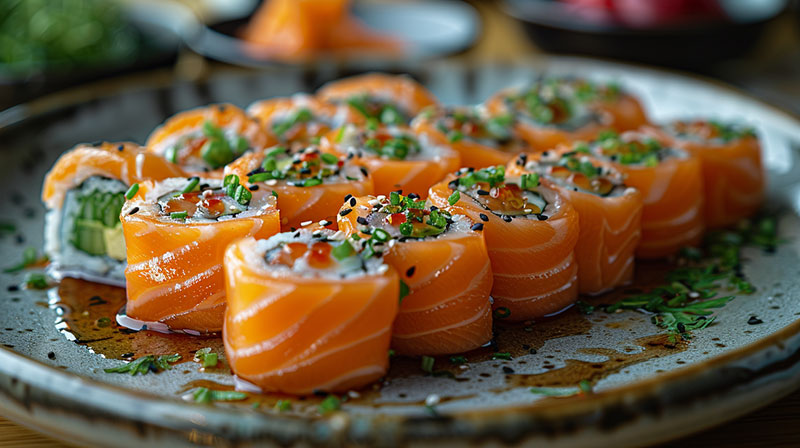Salmon sushi is more than just food; it’s a delightful journey into the rich tapestry of culinary arts influenced by Japanese tradition. Known for its vibrant color and delicate taste, salmon is a favorite among sushi lovers. Making salmon sushi at home requires attention to freshness and quality, ensuring that every bite is not only delicious but also safe. This guide will walk you through each step, from selecting the right salmon to the final presentation, helping you enjoy the delightful culinary journey.
Step 1: Selecting the Right Salmon
The first step in your sushi-making adventure is choosing the right salmon. It’s crucial to use only sushi-grade salmon, which denotes a higher standard of freshness and handling. This type of salmon is specifically prepared and stored to be consumed raw, significantly reducing the risk of foodborne illness. You can purchase sushi-grade salmon from reputable seafood markets or specialty stores. Engage with your fishmonger to understand the source of the salmon and its freshness. This direct communication helps ensure you’re getting the best product that’s been handled properly. Ensuring the quality of your salmon is paramount, as it will be eaten raw, and the quality directly affects both the taste and safety of your sushi.
Step 2: Preparation Before Slicing
Before you start slicing, proper preparation of the salmon is crucial to ensure it is safe for sushi. According to culinary experts, one key safety measure is freezing the salmon at -4°F (-20°C) for a minimum of 7 days. This process is vital as it helps eliminate any parasites present in the fish, ensuring it is safe for raw consumption. After the freezing period, it’s important to thaw the salmon slowly and properly in the refrigerator. This gradual thawing helps maintain the integrity of the fish’s texture and flavor, making it ideal for sushi. Taking these steps seriously minimizes health risks and enhances your sushi experience.
Step 3: Slicing the Salmon
The art of slicing salmon is crucial for achieving perfect sushi. To ensure even, delicate pieces that enhance the overall dining experience, the salmon should be cut against the grain. This technique is pivotal as it not only enhances the texture but also the visual appeal of the sushi. When it comes to slicing the salmon, a kiritsuke knife can be exceptionally effective. The kiritsuke knife, with its angled tip and versatile blade, allows for slicing with both precision and finesse. This dual-functionality makes the kiritsuke knife a favored choice. Be sure to clean the knife properly before and after slicing to maintain hygiene and prevent cross-contamination.
Assembling the Sushi
The assembly of your sushi is a delicate process that begins with the preparation of sushi rice. This rice should be seasoned with a balanced mixture of rice vinegar, sugar, and salt to achieve the perfect sushi flavor. Spread the rice thinly and evenly over a sheet of nori to form a stable base. Place a slice of your meticulously cut salmon on top of the rice. Using a bamboo mat, carefully roll the nori, ensuring the rice and salmon are tightly enclosed. For an artistic and flavorful touch, garnish your sushi rolls with ingredients like creamy avocado slices, crisp cucumber, or a dab of fiery wasabi. This not only adds a burst of flavor but also enhances the visual appeal of your sushi, making it as beautiful to look at as it is delicious to eat. Each element should be thoughtfully placed to create a harmonious blend of flavors and textures.
Serving and Enjoyment
Presentation plays a big part in the enjoyment of salmon sushi. Arrange the pieces elegantly on a platter, accompanied by soy sauce, pickled ginger, and wasabi. The freshness of the salmon paired with the tangy flavors of the condiments provides a perfect balance. Pair your sushi with a light sake or green tea for a traditional dining experience.
Conclusion
Making salmon sushi at home is a rewarding experience that combines skill with artistic presentation. Each step, from selecting the right fish to the final arrangement on the plate, is a testament to the culinary tradition of sushi. Experiment with different types of sushi to refine your technique and palate.

